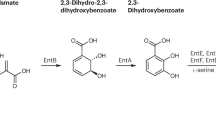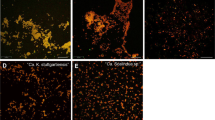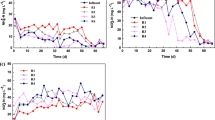Abstract
The limited iron uptake efficiency of anaerobic ammonium oxidation (anammox) bacteria has garnered accumulating concerns, as iron plays an important role in anammox bacteria metabolism. Siderophores are a prevalent strategy for iron acquisition among many bacteria, and recent evidence has suggested the potential role of siderophore-Fe3+ as bioavailable iron sources to anammox bacteria. Nonetheless, what target siderophore anammox bacteria can use and how they use it remain poorly understood. Here we shed fresh light on siderophore selectively promoting iron uptake and regulating the metabolic activity of anammox bacteria. Batch experiments and long-term operations demonstrated that siderophores catechin (CAT) and N-hydroxyethyl ethylenediamine triacetic acid (HEDTA) increased the iron uptake efficiency of anammox consortia up to 50%–65% and triggered the cofactors synthesis for key enzymes assembly, thereby selectively enhancing the anammox activity (≥350 mg N per gram of volatile suspended solids per day) and nitrogen removal efficiency (≥85%). Integrated with multi-omics approaches, we revealed versatile iron uptake pathways within anammox bacteria genera: Candidatus Brocadia acquired CAT-Fe3+ and HEDTA-Fe3+ via outer membrane receptors FitA/TbpA and FecA, respectively, whereas Candidatus Jettenia initially reduced CAT-Fe3+ using NfnB enzyme before uptake via the FeoABC system. This work reveals a pivotal role of siderophores in selectively enhancing anammox bacteria by optimizing their iron uptake and utilization and uncovers the involved molecular mechanisms, which opens promising avenues to optimize the anammox process with siderophore regulation for more efficient and sustainable wastewater treatment.
This is a preview of subscription content, access via your institution
Access options
Subscribe to this journal
Receive 12 digital issues and online access to articles
$119.00 per year
only $9.92 per issue
Buy this article
- Purchase on SpringerLink
- Instant access to full article PDF
Prices may be subject to local taxes which are calculated during checkout







Similar content being viewed by others
Data availability
The data generated in this study are included within the article and its Supplementary Information. Raw sequencing data have been archived in NCBI Sequence Read Archive under the accession number PRJNA1222017. Source data are provided with this paper.
References
Kartal, B., Kuenen, J. G. & Van Loosdrecht, M. C. M. Sewage treatment with anammox. Science 328, 702–703 (2010).
Andrews, S. C., Robinson, A. K. & Rodríguez-Quiñones, F. Bacterial iron homeostasis. FEMS Microbiol. Rev. 27, 215–237 (2003).
Kartal, B. & Keltjens, J. T. Anammox biochemistry: a tale of heme c proteins. Trends Biochem. Sci 41, 998–1011 (2016).
Ferousi, C. et al. Iron assimilation and utilization in anaerobic ammonium oxidizing bacteria. Curr. Opin. Chem. Biol. 37, 129–136 (2017).
Peng, M. W. et al. Insight into the structure and metabolic function of iron-rich nanoparticles in anammox bacteria. Sci. Total Environ. 806, 150879 (2022).
Kappler, A. et al. An evolving view on biogeochemical cycling of iron. Nat. Rev. Microbiol. 19, 360–374 (2021).
Zhang, L. & Okabe, S. Ecological niche differentiation among anammox bacteria. Water Res. 171, 115468 (2020).
Cao, M. et al. Spatial IMA1 regulation restricts root iron acquisition on MAMP perception. Nature 625, 750–759 (2024).
Santus, W. et al. Mycobiota and diet-derived fungal xenosiderophores promote Salmonella gastrointestinal colonization. Nat. Microbiol. 7, 2025–2038 (2022).
Endicott, N. P., Rivera, G. S. M., Yang, J. & Wencewicz, T. A. Emergence of ferrichelatase activity in a siderophore-binding protein supports an iron shuttle in bacteria. ACS Central Science 6, 493–506 (2020).
Gu, S. H. et al. Competition for iron drives phytopathogen control by natural rhizosphere microbiomes. Nat. Microbiol. 5, 1002–1010 (2020).
Moynie, L. et al. The complex of ferric-enterobactin with its transporter from Pseudomonas aeruginosa suggests a two-site model. Nat. Commun. 10, 3673 (2019).
Arnold, F. M. et al. The ABC exporter IrtAB imports and reduces mycobacterial siderophores. Nature 580, 413–417 (2020).
Zhu, W. H. et al. Xenosiderophore utilization promotes Bacteroides thetaiotaomicron resilience during colitis. Cell Host Microbe 27, 376–388.e8 (2020).
Dong, Z. Y. et al. Directed regulation of anammox communities based on exogenous siderophores for highly efficient nitrogen removal. Water Res. 243, 120394 (2023).
Kramer, J., Oezkaya, O. & Kuemmerli, R. Bacterial siderophores in community and host interactions. Nat. Rev. Microbiol. 18, 152–163 (2020).
Manck, L. E. et al. Petrobactin, a siderophore produced by Alteromonas, mediates community iron acquisition in the global ocean. ISME J. 16, 358–369 (2022).
Liu, X. H. et al. Draft genome sequence of a “Candidatus Brocadia” bacterium enriched from activated sludge collected in a tropical climate. Genome Announce. 6, e00406–18 (2018).
Zheng, R. et al. Siderophore-mediated cooperation in anammox consortia. Environ. Sci. Technol. 59, 4003–4013 (2025).
Dai, B. et al. Enhancement and mechanisms of iron-assisted anammox process. Sci. Total Environ. 858, 159931 (2023).
Wang, H. et al. Function of Fe(III)-minerals in the enhancement of anammox performance exploiting integrated network and metagenomics analyses. Water Res. 210, 117998 (2022).
Kang, D. et al. Color characterization of anammox granular sludge: chromogenic substance, microbial succession and state indication. Sci. Total Environ. 642, 1320–1327 (2018).
Ye, J. H. et al. Diversity and dynamic response of anaerobic ammonia oxidation granular sludge. J. Environ. Sci. 152, 262–275 (2025).
Jiang, Y. S. et al. Novel insight into the inhibitory effects and mechanisms of Fe(II)-mediated multi-metabolism in anaerobic ammonium oxidation (anammox). Water Res. 242, 120291 (2023).
Wang, H. et al. Metagenomics insight into the long-term effect of ferrous ions on the mainstream anammox system. Environ. Res. 238, 117243 (2023).
Lu, P. et al. Molecular mechanism of Fe3+ binding inhibition to Vibrio metschnikovii ferric ion-binding protein, FbpA, by rosmarinic acid and its hydrolysate, danshensu. Protein Sci. 33, e4881 (2024).
Klebba, P. E. et al. Iron acquisition systems of gram-negative bacterial pathogens define TonB-dependent pathways to novel antibiotics. Chem. Rev. 121, 5193–5239 (2021).
Chicano, T. M. et al. Structural and functional characterization of the intracellular filament-forming nitrite oxidoreductase multiprotein complex. Nat. Microbiol. 6, 1129–1139 (2021).
Swayambhu, G., Bruno, M., Gulick, A. M. & Pfeifer, B. A. Siderophore natural products as pharmaceutical agents. Curr. Opin. Biotechnol. 69, 242–251 (2021).
Kang, D. et al. Deciphering correlation between chromaticity and activity of anammox sludge. Water Res. 185, 116184 (2020).
Yang, T. H. et al. Specificity and mechanism of TonB-dependent ferric catecholate uptake by Fiu. Front. Microbiol. 15, 1355253 (2024).
Sexton, D. J. & Schuster, M. Nutrient limitation determines the fitness of cheaters in bacterial siderophore cooperation. Nat. Commun. 8, 230 (2017).
Liu, L. L., Wang, W., Wu, S. H. & Gao, H. C. Recent advances in the siderophore biology of Shewanella. Front. Microbiol. 13, 823758 (2022).
Leventhal, G. E., Ackermann, M. & Schiessl, K. T. Why microbes secrete molecules to modify their environment: the case of iron-chelating siderophores. J. R. Soc. Interface 16, 20180674 (2019).
Wilson, B. R., Bogdan, A. R., Miyazawa, M., Hashimoto, K. & Tsuji, Y. Siderophores in iron metabolism: from mechanism to therapy potential. Trends Mol. Med. 22, 1077–1090 (2016).
Mayneris-Perxachs, J., Maria Moreno-Navarrete, J. & Manuel Fernandez-Real, J. The role of iron in host-microbiota crosstalk and its effects on systemic glucose metabolism. Nat. Rev. Endocrinol. 18, 683–698 (2022).
Biswakarma, J. et al. Linking isotope exchange with Fe(II)-catalyzed dissolution of iron(hydr)oxides in the presence of the bacterial siderophore Desferrioxamine-B. Environ. Sci. Technol. 54, 768–777 (2020).
van Bergeijk, D. A. et al. The ubiquitous catechol moiety elicits siderophore and angucycline production in Streptomyces. Comm. Chem. 5, 14 (2022).
Agrawal, S. et al. Time to act-assessing variations in qPCR analyses in biological nitrogen removal with examples from partial nitritation/anammox systems. Water Res. 190, 116604 (2021).
Acknowledgements
This work was supported by the National Science Fund for Distinguished Young Scholars (52225001).
Author information
Authors and Affiliations
Contributions
Y.W. conceived and led the project. J. Liu conceived and conducted the experiment, developed the figures and wrote the paper. H.W. analysed the microbial and statistical data and assisted with writing the paper. J. Li and M.Z. assisted with the analysis of the experimental data. Y.W., H.W. and J. Liu commented upon and revised the manuscript. All authors discussed and interpreted the results and contributed to the manuscript.
Corresponding authors
Ethics declarations
Competing interests
The authors declare no competing interests.
Peer review
Peer review information
Nature Water thanks the anonymous reviewers for their contribution to the peer review of this work.
Additional information
Publisher’s note Springer Nature remains neutral with regard to jurisdictional claims in published maps and institutional affiliations.
Extended data
Supplementary information
Supplementary Information
Supplementary Texts 1–7, Figs. 1–7 and Tables 1–5.
Source data
Source Data Figs. 1–3, 5 and 6
Statistical source data for Figs. 1–3, 5 and 6.
Rights and permissions
Springer Nature or its licensor (e.g. a society or other partner) holds exclusive rights to this article under a publishing agreement with the author(s) or other rightsholder(s); author self-archiving of the accepted manuscript version of this article is solely governed by the terms of such publishing agreement and applicable law.
About this article
Cite this article
Liu, J., Li, J., Wang, H. et al. Siderophores as a selective regulator for enhancing anaerobic ammonium oxidation bacteria. Nat Water 3, 806–817 (2025). https://doi.org/10.1038/s44221-025-00459-y
Received:
Accepted:
Published:
Issue date:
DOI: https://doi.org/10.1038/s44221-025-00459-y



